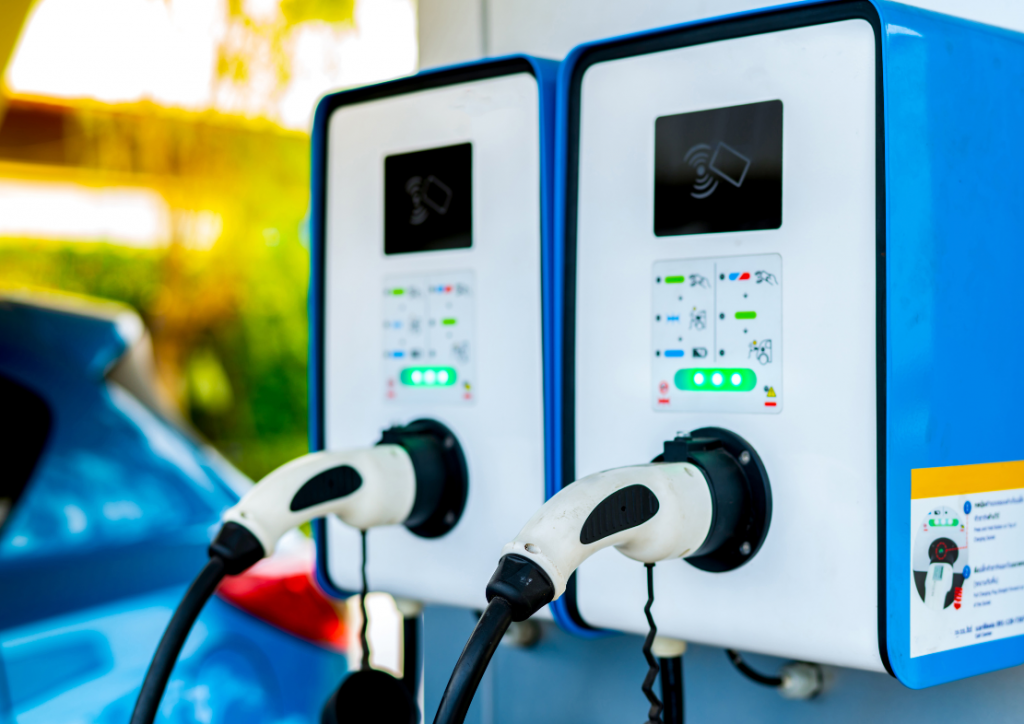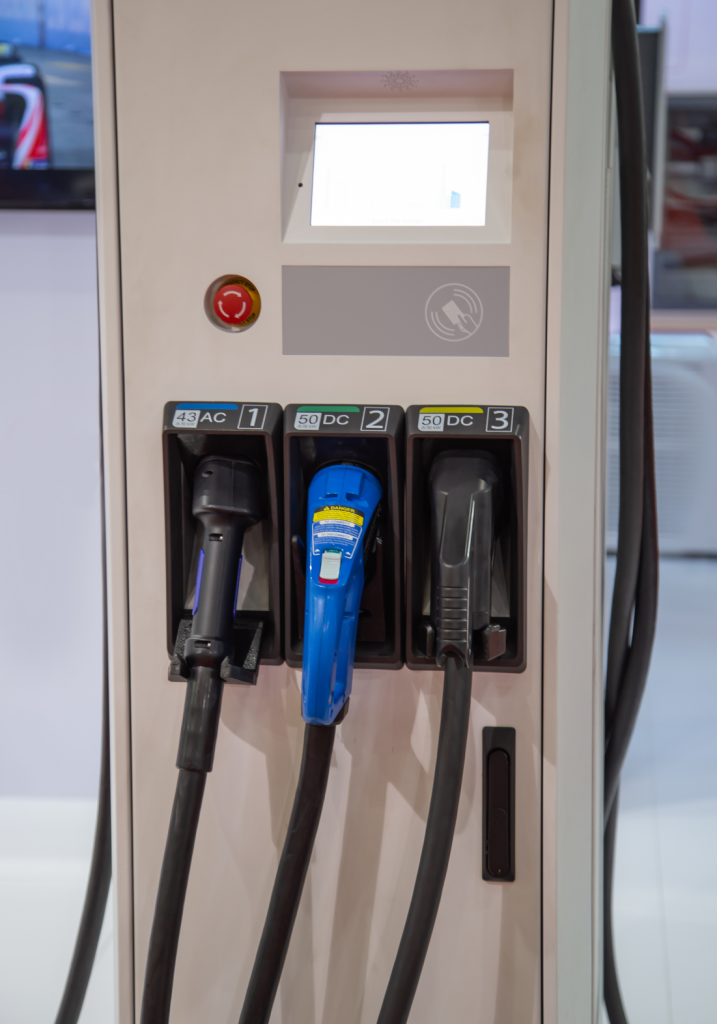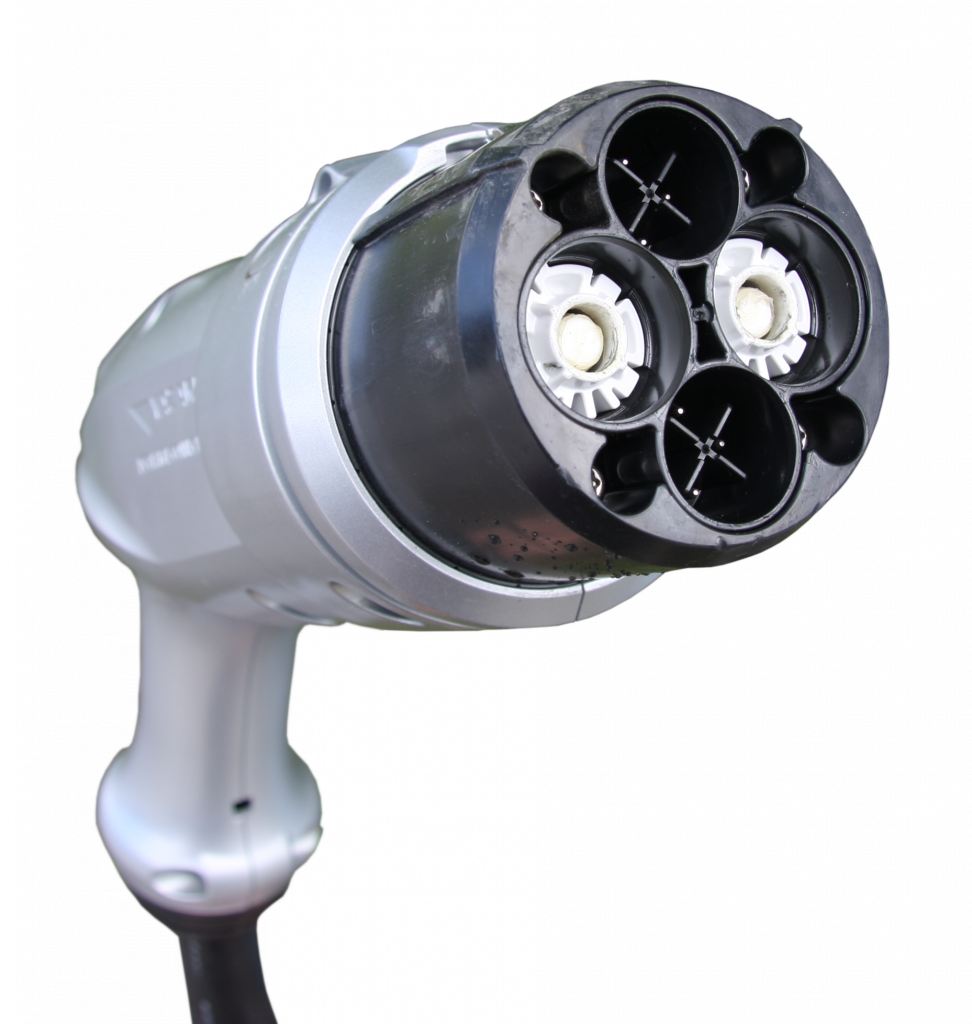Homeowners continuously search for ways to save money on their energy bills, particularly those who drive EVs. One clever way to achieve this is by charging an EV with solar panels!
This guide will demonstrate just how easy it is to set up a charging station in your home using solar power.
What’s more, it will discuss the benefits of using solar energy to charge your EV and some of the best ways to take advantage of this cost-effective strategy.
Let’s get started!
Table of Contents
Can You Charge An Electric Car With Solar Panels?
As electric vehicles (EVs) continue gaining traction, many people wonder if they can charge their cars with solar panels. The short answer is yes, it is possible to charge an EV with solar panels.
That said, a few things to remember before making the switch. For starters, charging an EV with solar panels requires a more extensive solar array as these vehicles require more energy and have larger batteries that demand frequent charging.

Additionally, charging an EV with solar panels can take longer than charging with a standard outlet because your charging method relies on sunlight. Therefore, it may take longer to charge an EV on cloudy days or at night.
Finally, consulting a qualified electrician before installing a solar charging system for your EV is essential. Doing so will ensure proper installation and, therefore, safe charging.
With these things in mind, charging an EV with solar panels is a great way to reduce your carbon footprint and save money on fuel costs.
How Much Money Can You Save By Charging Your EV With Solar?
To answer this question, we need to look at the cost of charging an EV without solar, then compare it to the cost of charging an EV with solar.
The average cost of charging an EV without solar is about $0.15 per kilowatt-hour (kWh). However, the cost of charging an EV with solar can be as low as $0.08 per kWh — a savings of 47%.
The Cost Of Installing Solar Panels
The cost of generating electricity from solar panels also varies depending on the solar system you install.
The initial cost of installing a photovoltaic (PV) system can range from $15,000 to $40,000. This cost has been dropping steadily due to technological advances and efficiency increases.
After factoring in federal and state tax credits, the net cost of installing a PV system can be as low as $5000.
Return On Investment (ROI) Example
Charging an electric car (EV) is a significant portion of your total ownership costs. Solar panels can help offset this cost and, in some cases, eliminate it.
Let’s consider the following ROI calculation:
| Charging EV With Solar (Home) | Gasoline Vehicle | |
|---|---|---|
| Average Fuel Cost | $0.08/kWh | $3.88/gal |
| Average Miles Per Year | 13,476 mi. | 13,476 mi. |
| Range | 250 mi. (On A Single Charge) | 453.25 mi. (Tank Size = 18.5 gal) |
| Total Cost Per Year | $323.42 | $2,135.81 |
The average cost of charging an EV at home is $0.08, and the average price of gasoline is $3.88.
According to the Federal Highway Administration, US citizens drive an average of 13,476 miles annually.
Let’s assume your EV reaches 250 miles on a single charge, and a gasoline vehicle with an average tank size of 18.5 gallons reaches 453.25 miles. This translates to a total cost of $323.42 for charging your EV at home and $2,135.81 in gasoline per year.
Now, let’s look at the ROI — your overall saving in fuel cost per year is $1,812.38, and the cost of installing a 10kW solar panel system is $21,756.
The payback period for charging an EV with solar panels is twelve years.
Based on these calculations, it is clear that charging an EV with solar panels is a wise investment for homeowners. Not only will this method help you save money on charging costs, but it will also provide you with an ROI within a few years.
Remember: if you are considering charging your EV with solar panels, be sure to calculate the ROI before making a decision.
Difference Between Home Charging And Level 1, 2 & 3 Chargers
Most people know they can charge an EV with solar panels but may not know the details.
There are three charging stations for electric vehicles: Level I, II, and III. Each type has its benefits and drawbacks.
Level 1 Chargers

Level 1 charging stations use a standard 120-volt outlet. This is the slowest way to charge an EV — it takes between 8-20 hours to reach full charge (depending on the battery size).
The main benefit of level 1 charging is that you can do it at home with no extra equipment required beyond a special adapter cord.
Level 2 Chargers

These stations use a 240-volt outlet. The charging cycle is much faster than Level 1 — it takes 2-8 hours to reach full charge.
These chargers require professional installation and can cost between $500 and $2000.
Level 3 Chargers

These charging stations are also known as DC fast chargers. They use a 480-volt outlet and can fully charge an EV in 30 minutes to 1 hour.
Price-wise, Level 3 charging stations are the most expensive to install, costing between $5000 and $45000.
Solar Panels And Charging Levels
Solar panels can power all three types of charging stations. The amount of solar panels needed to power a charging station depends on the charging level. Naturally, faster-charging speeds require more solar panels.
Size-wise, solar panel arrays for electric vehicle charging stations range from 2kW to 10kW.
Related Reading: How Long Does It Take To Charge An EV? (120V, 220V & 440V)
Step-By-Step Guide To Charging Your Electric Car With Solar Panels
Step 1. Determine How Much Power You Need
The amount of power you need will depend on the size of your EV battery and the charging speed you want to achieve.
An EV uses on average 0.32kWh/miles and 1kW of solar panels in California produces around 5kWh per day. That translates into 6.5 kilowatt (kW) of solar panels for every 100 miles of range you want to add to your EV per charging session.
Determine Your Charging Speed
To do this, consult your EV’s owner manual or contact the manufacturer. Once you know how much power you need, you can start sizing your solar panel system.
Determine The Size Of Your Property
You must also determine the size of your property. This will help you determine the number of solar panels you’ll need to charge your EV.
Remember that the amount of power your panels produce will vary depending on sunlight intensity, panel orientation, and temperature. Therefore, it’s crucial to factor in a margin of error when sizing your system.
A good rule of thumb is to select panels that will generate 20-25% more power than you need. In our example, 2kW x 25% = 2.5kW, so you need 10 panels instead of 8.
Please note: solar panels are typically rated in watts (W), so you must calculate the number of panels required to generate the desired power. For example, if you need 2kW of power and each panel produces 250W, you will need 8 panels.
Step 2. Determine The Type Of Your EV Charging Cable
First, consider the amperage and voltage of your solar panels. Most home solar arrays have a low voltage (12-24 volts), but the amperage can vary.
You’ll also need to know your EV battery pack’s maximum charging current. You’ll find this information in your owner’s manual or the manufacturer’s website.
With this information, you can calculate the required cable gauge (thickness) using an online calculator or consulting with a qualified electrician. In general, thicker cables (lower gauge numbers) can carry more current but may be more expensive and challenging to work with.
However, you’ll likely need thicker cables to handle the higher charging currents if you’re charging a high-powered EV like a Tesla Model S.
Related Reading: Advice On Buying An EV Charging Cable (Buyers Guide)
Step 3. Determine The Charge Level
The type of cable you need also depends on your charging station. You’ll need a DC fast charging cable if you have a DC fast charging station. Most home charging stations are Level 2, so you’ll likely need a Level 2 charging cable.
The amount of charge you’ll need will depend on how often you drive, the length of your commute, and other factors. One way to determine your required charging level is to consider your average daily driving habits.
For instance, if you commute 30 miles daily, you’ll need about 30 miles of charge every day. You can also use a charging calculator to estimate your charging needs based on your driving habits.
Step 4. Check Your EVs Charging Port
The three most common types of charging ports are J1772, Tesla’s Supercharger, and CHAdeMO.
J1772 charging ports are found on most EVs today. They usually have a small flap that covers the charging port when not in use.

Source: Yazaki Corporation
Tesla’s Supercharger is a charging port specific to Tesla vehicles. It’s much larger than a J1772 port and is located on the front of the car.

Source: Tesla
CHAdeMO charging ports are found on some Japanese-made EVs. They’re similar in size to a J1772 port but have a different connector. If you’re unsure what type of charging port your EV has, consult your owner’s manual or contact the manufacturer.

Source: CHAdeMO Association
Step 5: Find A Reputable Company To Install The System
Many companies offer this service, so it is essential to do your research to find one that is reputable and has a good track record.
Once you’ve found a company that you feel comfortable with, they will help you determine the best location for your solar panels and provide you with all the necessary equipment.
They will also be able to provide you with information on how to get the most out of your solar charging system.
Related Reading: What Is Vehicle-To-Grid (V2G) Charging & Discharging?
Steps To Consider Before Making The Switch To Solar
1. Pay Attention To Your Electricity Bill
How much energy do you use every month? If you live in a sunny climate and have a south-facing roof, you may be able to generate enough energy to offset your entire electric bill. But if you live in a cloudy climate or have a north-facing roof, you may only be able to offset a portion of your bill.
2. Consider The Upfront Cost Of Solar Panels
Solar panels can be expensive, so you’ll need to ensure the savings on your electric bill will offset the installation cost over time.
3. Inspect Your Roof
Install the solar panels on a robust and stable roof. If your roof is in poor condition, it may not be able to support the weight of the panels.
4. Think About The Future
Are you planning on selling your home in the near future? Solar panels increase the value of your home. Are you prepared to maintain your solar panels if you’re not planning on selling them? Solar panels require occasional cleaning and maintenance to continue functioning correctly.
After considering all of these factors and deciding that solar panels are right for you, there are a few things you’ll need to do to get started.
Contact your utility company and let them know you’re interested in installing solar panels. They may have rebate programs or other incentives to help offset the installation cost.
Tips For Maintaining Your Solar Panel System
Solar panels are a great way to save money on your electric bill and help the environment. But, like any investment, they require ongoing maintenance to function optimally.
Here are a few tips for maintaining your solar panel system over time:
Keep Them Clean
Solar panels must be clean and free of debris to function correctly. You can periodically wipe the panels with a soft cloth or use a hose to wash away any dirt or debris.
For a more in-depth guide to washing your solar panels, check out our article, How To Clean Solar Panels (DIY Tips & Advice).
Check For Damage
Inspect your solar panels regularly for cracks or other damage that could reduce their efficiency. If you notice any damage, contact a professional for repairs.
Keep Trees Trimmed
Overhanging tree limbs can shade your solar panels and prevent them from charging correctly. Trim any branches that are shading the panels.
Track Your Electrical Bill
Keep an eye on your electric bill. If you see a sudden increase, it could be an indication that something is wrong with your system.
By following these simple tips, you can keep your solar panel system running smoothly for years to come.
Charging Your EV With Solar Panels: Advantages
Solar charging stations for electric cars are becoming more and more common as the advantages of charging with solar panels become clear.
- Solar energy is freely available.
- Solar charging is environmentally friendly — it reduces your reliance on fossil fuels.
- Charging your car with solar panels can be a great backup option during a power outage.
- Solar charging is cost-effective as the initial investment in solar panels pays for itself over time.
Charging Your EV With Solar Panels: Disadvantages
- Solar panels can be expensive to install, and you’ll need a sunny location for them to be effective.
- Charging an EV with solar panels takes longer than charging from a traditional outlet. It may not be the best option if you’re in a hurry.
- Solar panels can put stress on your home’s electrical system. As a result, you may need to upgrade your system or add additional batteries to accommodate the extra demand.
- Solar panel charging is most effective during the daytime. If you want to charge your EV overnight, you’ll need to invest in solar battery storage.
Charging Your EV With Solar Panels: FAQ
How Much Does It Cost To Charge An EV With Solar Panels?
The cost will depend on the size of your solar panel system and the efficiency of your car’s charging system. However, charging an electric vehicle with solar panels is typically cheaper than charging with grid power.
How Many Solar Panels Do I Need To Charge An EV?
This will depend on the size of your car’s battery and the efficiency of your charging system. Typically, you’ll need between 4 and 8 solar panels to charge an electric vehicle.
How Long Does It Take To Charge An EV With Solar Panels?
It can take anywhere from 8 hours to overnight, depending on the size of your battery and the efficiency of your charging system. However, most people find that charging their EV with solar takes about as long as charging it with grid power.
Is Charging An EV With Solar Panels Safe?
Yes, charging an EV with solar panels is as safe as charging it from a charging station or outlet. The same standards regulate the charging process, so you can be sure that your EV will charge safely and efficiently.
Final Thoughts
Charging your EV with solar panels is a great way to save money on fuel costs, and it’s also good for the environment.
However, before making the switch, you must consider factors such as the installation cost and potential stress on your home’s electrical system.
If you’re thinking about charging your electric car with solar panels, be sure to do your research and weigh the pros and cons.
Thanks for reading!

